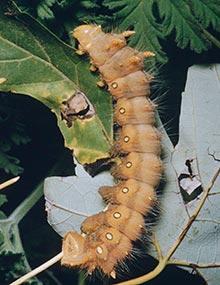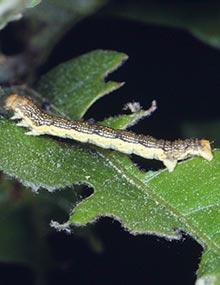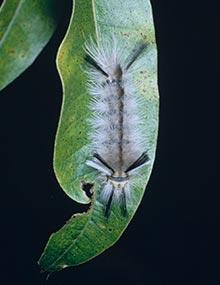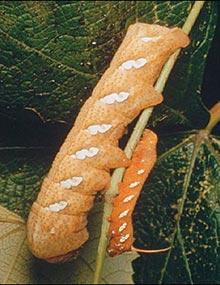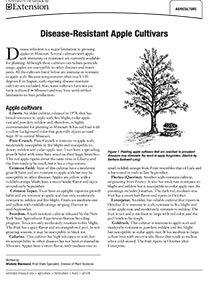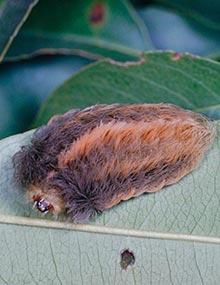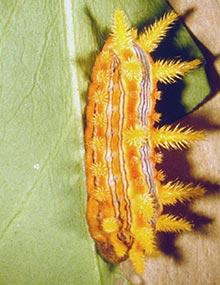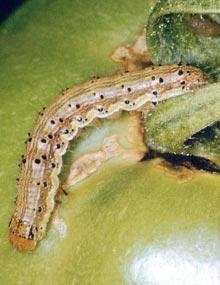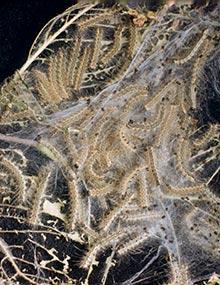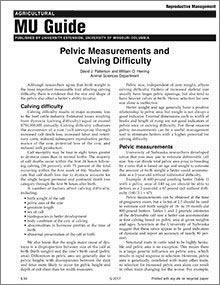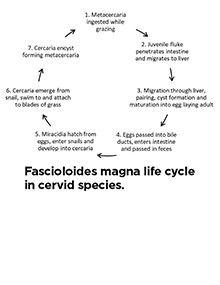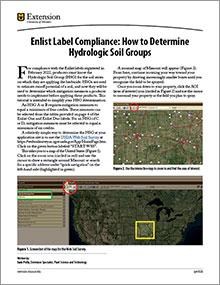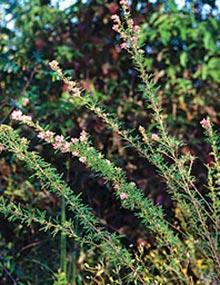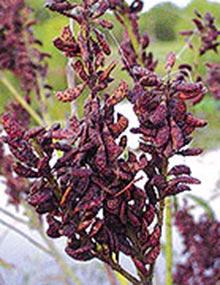Caterpillars in Your Yard and Garden, Page 25
Reviewed
Imperial moth caterpillars (Eacles imperialis) are present from June to August. They produce two generations per year. Common host plants include oaks, sweetgum, maple, hickory, sassafras, elm and sycamore.
Caterpillars in Your Yard and Garden, Page 28
Reviewed
Linden looper caterpillars (Erannis tiliaria) are present from late spring to summer. They produce one generation per year.
Caterpillars in Your Yard and Garden, Page 31
Reviewed
Pale tussock moth caterpillars (Halysidota tessellaris) are present from early summer to fall. They produce two generations per year.
Caterpillars in Your Yard and Garden, Page 02
Reviewed
Achemon sphinx caterpillars (Eumorpha achemon) are present from early summer to fall. They produce one to two generations per year.
Caterpillars in Your Yard and Garden, Page 34
Reviewed
Polyphemus moth caterpillars (Antheraea polyphemus) are present from May to October. They produce multiple generations per year.
Caterpillars in Your Yard and Garden, Page 05
Reviewed
Banded woollybear caterpillars (Pyrrharctia isabella) are present in the spring and from late summer to late fall. They produce one to two generations per year.
Caterpillars in Your Yard and Garden, Page 37
Reviewed
Roseslug caterpillars (Endelomyia aethiops) are present in summer. They produce one generation per year.
Caterpillars in Your Yard and Garden, Page 08
Reviewed
Catalpa sphinx caterpillars (Ceratomia catalpae) are present from early summer to early fall. They produce multiple generations per year.
Caterpillars in Your Yard and Garden, Page 40
Reviewed
Spicebush swallowtail caterpillars (Papilio troilus) are present from May to October. They produce two to three generations per year.
Caterpillars in Your Yard and Garden, Page 11
Reviewed
Crinkled flannel moths caterpillars (Lagoa crispata) are present in summer and fall. They produce two generations per year.
Caterpillars in Your Yard and Garden, Page 43
Reviewed
Stinging rose caterpillars (Parasa indetermina) are present in summer and fall. They produce one to two generations per year.
Caterpillars in Your Yard and Garden, Page 14
Reviewed
Eight-spotted forester caterpillars (Alypia octomaculata) are present from spring to early fall. They produce one to two generations per year.
Caterpillars in Your Yard and Garden, Page 46
Reviewed
Tomato fruitworm, corn earworm caterpillars (Helicoverpa zea) are present in mid-June. They produce two generations per year.
Caterpillars in Your Yard and Garden, Page 17
Reviewed
Fall webworm caterpillars (Hyphantria cunea) are present from spring to fall. They produce two to three generations per year.
Caterpillars in Your Yard and Garden, Page 49
Reviewed
Variegated fritillary caterpillars (Euptoieta claudia) are present from June to October. They produce multiple generations per year.
Reducing Losses When Feeding Hay to Beef Cattle
Reviewed
Feeding hay to cattle is expensive, mostly due to waste. Learn good management practices to minimize the losses that occur due to poor storage methods, improper feeding methods, or both.
Pelvic Measurements and Calving Difficulty
Reviewed
Although researchers agree that birth weight is the most important measurable trait affecting calving difficulty, there is evidence that the size and shape of the pelvis also affect a heifer’s ability to calve.
Liver Flukes in Missouri: Distribution, Impact on Cattle, Control and Treatment
Reviewed
Cattle operations should evaluate their risk for is Fascioloides magna, also known as the deer fluke or the giant liver fluke. Learn about its distribution in Missouri, its life cycle, treatment and more in this guide.
Enlist Label Compliance: How to Determine Hydrologic Soil Groups
New
Learn how to use the USDA Web Soil Survey interactive map to determine your field's hydrologic soil group for the soil series on which you plan to apply an Enlist herbicide.
Missouri Farm Labor Guide
Revised
Learn good human resource practices related to employee recruitment, hiring, onboarding, training and termination that your farm or agribusiness can use.
Quail-Friendly Plants of the Midwest, Page 48
Reviewed
Slender lespedeza leaves are divided into three leaflets 1 to 1-1/2 inches long and less than 1/4 inch wide. Stems are upright, up to 3 feet tall. Flowers are pink to purple and occur in clusters toward the top of the plant.
Quail-Friendly Plants of the Midwest, Page 16
Reviewed
False indigo occurs in moist ground in thickets along streams, rocky banks, pond borders and open wet woods. The leaves are pinnately compound. The dense flower clusters are deep purple to blue and produce numerous fruits that mature in late summer.
Quail-Friendly Plants of the Midwest, Page 51
Reviewed
Sunflowers exhibit a variety of characteristics, but most of the commonly encountered species have triangular to lanceolate leaves, rough leaf surfaces and conspicuous yellow flowers.
